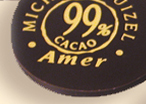
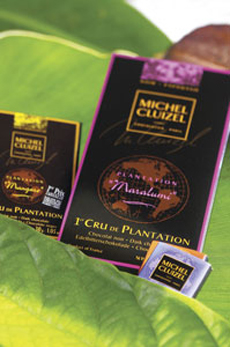
The great chocolate houses make some of their best bars from single plantation beans. Today's premier cru chocolate bars are much like fine wines: experts can tell in blind tastings what kind of cacao beans the bars are made from, and where the beans were grown. these from the Maralumi plantation of Papua, New Guinea, made by Michel Cluizel.
|
PETER ROT was first schooled in chocolate by his German mother. After an epiphanic taste of Valrhona Le Noir Amer 71%, his passion for chocolate became a full-fledged scholarly pursuit. Peter is a moderator of a discussion forum of international chocolate connoisseurs and a reviewer for the international chocolate community. He is pursuing a graduate degree in the cultural significance of food.
Peter welcomes your comments and questions. Click here to e-mail him.
|
May 2005
Last Updated February 2012
|
 |
House Tour: The World’s Great Gourmet Chocolate Producers
And How Each “House” Differs In Style
On our first tour, in 2005, we visited these great chocolate producers (in alphabetical order): Amedei (Italy), Chocovic (Spain), Domori (Italy), El Rey (Venezuela), Michel Cluizel (France), Pierre Marcolini (Belgium), Pralus (France), Scharffen Berger* (U.S.),
and Valrhona‡ (France).
*Kosher †Organic ‡Some Organic Items
In 2006, our tour took us to Bonnat* (France) Dagoba*† (U.S.), Guittard* (U.S.),
Plantations (U.S.) and Santander* (Colombia). Whither in 2007? So much great
chocolate, so little time! Stay tuned!
Chocolate is manufactured in the majority of countries on earth. Good chocolate is produced in many places. But we have chosen just six countries on our first tour of the greatest chocolate in the world—nine producers in all.
To be selected for our worldwide tour, a company must be a “chocolate house”—a producer that purchases raw cacao beans to roast and process into chocolate, from which it creates:
- Chocolate bars for consumer consumption
- Commercial blocks of couverture chocolate from which pastries, bonbons and all other consumer chocolates are made.
Most houses in turn sell their couverture to other companies who create their own chocolate products from it—large concerns as well as neighborhood chocolatiers, bakeries, and restaurants. Some great producers only make couverture for the commercial market. It is great chocolate, but it is not on our tour because you can’t purchase a bar of it. And there are other wonderful producers, not on this maiden voyage, who make excellent consumer chocolate and couverture. We hope to visit more of them on our next trip.
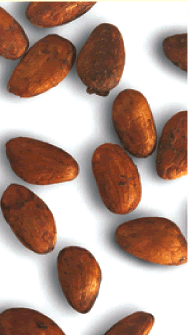 When buying their couverture, chocolatiers and patissiers generally choose one house over another because of how the house style of the chocolate matches the palate of the chocolatier/patissier and what he or she is trying to achieve with a particular recipe. Each chocolate house has its own “recipe” for making couverture and bar chocolate—how long they roast the beans for light and fruity versus dark tones; how long they conch the chocolate for texture; whether they emulsify for smoothness; whether they add extra cocoa butter for creaminess; et al. How they treat the beans at each step in the process results in an identifiable “house style,” whether the cacao beans come from Venezuela or from Madagascar. When buying their couverture, chocolatiers and patissiers generally choose one house over another because of how the house style of the chocolate matches the palate of the chocolatier/patissier and what he or she is trying to achieve with a particular recipe. Each chocolate house has its own “recipe” for making couverture and bar chocolate—how long they roast the beans for light and fruity versus dark tones; how long they conch the chocolate for texture; whether they emulsify for smoothness; whether they add extra cocoa butter for creaminess; et al. How they treat the beans at each step in the process results in an identifiable “house style,” whether the cacao beans come from Venezuela or from Madagascar.
Photo of cacao beans courtesy of Chocolate El Rey.
Otherwise stated, bars made by three different houses from the same harvest of Porcelana beans will be noticeably different in style. even though the bread, butter and jam qualities of the Porcelana bean will shine through. By the end of this article, you will understand why Bar 1 may be smoother, Bar 2 pastier, Bar 3 darker in tones, and so forth. All Porcelana, all excellent, all uniquely delicious in the style of their houses.
About Our Trip
THE NIBBLE’s maiden voyage takes us to Belgium, France, Italy, Spain, the United States and Venezuela. The great houses in these countries create chocolate bars the quality and complexity of which are pursued and discussed with the same kind of reverence that oenophiles accord the Premier Crus of Bordeaux. That’s because over the past 20 years, a quiet revolution has occurred in the world of prestige chocolate.
Fine chocolate today is a world of single origin bars, where the beans from one plantation in Venezuela are as unique and revered as the grapes of Chateau d’Yquem. It is a world where chocolate houses, like Burgundian vintners, make their house blends, their premier crus, and their single origin products. And as with great wines, the experts can sniff and taste and deduce with studied accuracy not only the kind of bean the bar is made from, but the part of the world, country, and even the plantation the beans call home.
So, join chocolate expert Peter Rot as he tours the greatest chocolate houses in the world—those that produce the finest chocolate bars¹ money can buy and palates can savor. This “tour” is a substantial education on chocolate, and the only publicly-available article we know of that has undertaken such an in-depth articulation of the differences among the great chocolate producers.
-
If you’re new to chocolate scholarship, you will gain a fundamental understanding of the players and why you prefer the taste of one brand over another. We encourage you to purchase the bars discussed and “taste along” with the article.
-
If you would like to brush up on chocolate terminology, you can read THE NIBBLE’s Chocolate Glossary before taking the tour.
- If you’re kosher, you can enjoy the chocolates of these top producers: Bonnat, Dagoba, Guittard, Santander and Scharffen Berger.
- If you’re an expert and have comments to share, we’d enjoy hearing from you. You can e-mail the author, or e-mail the editors.
Bon voyage!
¹ A house is judged by connoisseurs on the quality of its plain bar chocolate, the purest expression of their product. While most of the houses in this article produce bars with nuts, fruit, and infused flavors, plus bonbons and other chocolate products, our focus in this article is on plain bar.
The Tour Begins
ON THIS PAGE:
 France France
France possesses a great culinary heritage, and it’s no surprise that it is the only country to clinch three of the coveted nine spots on our international tour.
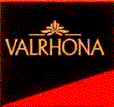 Valrhona Valrhona
Smooth • Black Fruits • Floral
Historic Capsule
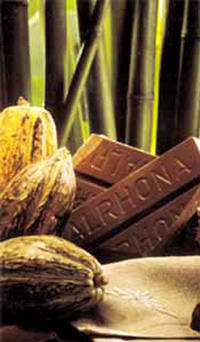
Nestled in the middle of the famous vineyards of Tain l’Hermitage in the Rhone Valley, France, the company was established by a pâtissier named Albéric Guironnet, in 1922. The original name was La Chocolaterie de Vivirais, but as the company grow, in 1947, it changed its name to Valrhona, reflecting its Rhone Valley home. An acclaimed pioneer in the prestige chocolate world, Valrhona was among the first brands to introduce Grand Cru and Vintage chocolate bars, in which all the beans come from the same geographical region (Grand Cru) or the same harvest season (Vintage). This bean selection results in aromas and flavors that emphasize the uniqueness of the cacao from the specific locale. (Consider the analogy of the different characteristics of juice yielded by cabernet sauvignon grapes from Pomerol vs. Graves in Bordeaux, or from cabernet grapes in Bordeaux vs. California vs. Australia.) However, Valrhona did not sell its chocolate direct to the consumer until 1986—prior to then it sold couverture only to chocolate manufacturers.
What to Know Before You Go
The majority of Valrhona’s chocolate have a light fruity or floral tone, as a result of the house style of light roasting. The bars also might taste sharp or even tannic due to both the roasting and the fermentation of the beans.² The exception to the house style is Gran Couva, which has no fruitiness whatsoever due to the nature of the bean.
Of all prestige chocolate brands, Valrhona’s texture is the textbook example of smoothness. To a connoisseur, it calms, relaxes, and soothes the palate and inner self into a medley of chocolate bliss.
²Fruity and floral tones are flavors of the bean; sharp and tannic tones result from lighter roasting and perhaps short fermentation. As a result, the combination will taste fruity and sharp. If you try Pralus’ Jamaica bar, for example: It tastes tannic, yet has that dark tone looming throughout.
Points of Interest
-
The Dawn of Grand Cru Bars. In the 1980s Valrhona pioneered what it called Grand Cru chocolates, precipitating a movement that grew into today’s connoisseurship: studying fine bar as one does fine wine, understanding the terroir (the soil components) and microclimate of the bean and their impact on the flavors and aromas in the chocolate that can come from its beans.
| |
- The first Grand Cru bar was the bittersweet Guanaja (Honduras, 70% cacao).
- It was an immediate hit and was followed by the Grand Crus Caraibe (Caribbean, 66% cacao—dark chocolate), Manjari (Madagascar, 64% cacao—dark chocolate), and Jivara (South America, 40% cacao—milk chocolate).
- This revolutionary step forward in the industry opened new doors (and awakened palates) in the world of designated-origin chocolates.
|
|
-
Vintage Bars Debut. In Valrhona’s Vintage line, each type of bar is produced from beans from one year’s harvest. Like vintage wines, each bar is labeled with its year of production. Plus, each bar is made from beans that come from a single plantation. All are 64% cacao.
| |
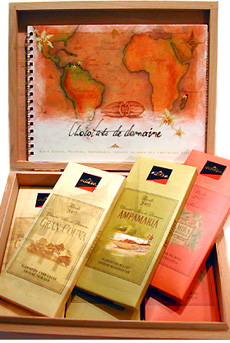 The first vintage chocolate to debut, Gran Couva from Trinidad, has notes of butter, pine, and soft spice. The first vintage chocolate to debut, Gran Couva from Trinidad, has notes of butter, pine, and soft spice.- Ampamakia, a Madagascar chocolate, has soft citrus and grape notes.
- Palmira, a Venezuelan criollo cacao from the Maracaibo region, is light on the palate; crisp on the tongue with a lingering acidity. Brought in to replace the departed Chuao (see below), its depth and texture do not quite hit the stride of the other Varhona bars.
- Chuao, a Venezuelan chocolate with tones of spice, lemon, and molasses, was discontinued in 2004 following the acquisition of Amedei to production of the crop from the town of Chuao.
- Calm and refreshing, these chocolates overwhelm with finesse rather than strength. They allow one to contemplate the difference in the yearly harvest, in addition to the origins of the cacao.
|
-
The Blended Bars. Like all houses, Valrhona offers an assortment of “house blend” bars, which means that each chocolate consists of mixed beans of various regions and types to achieve a consistent house style. These lines have chocolates bars of varying cocoa content from white chocolate (which has 0% cacao solids) to milk chocolate (30% to 45% cacao solids depending on the house), to semisweet chocolate (up to 69% cacao solids) to bitter chocolate (which can range from 70% up to 100% cacao,the latter of which has no sugar). Valrhona’s blended bars range from a caramel-like 40% milk to an exceptionally bitter and intense 85% dark.
- The factors of varying bean flavors, intensities, and selection, combined with a house’s characteristic style (such as roasting time and bean processing) will result in different tastes. So, for example, a 70% blended bar will taste different on a house-to-house basis. Even within the same house, chocolate of the same percentage from different regions will vary in flavor due to geographical location, weather, and even surrounding vegetation. And of course, chocolate from different houses, even though the beans come from the same region—even the same plantation—will taste different due to each house’s style.
Not to be Missed
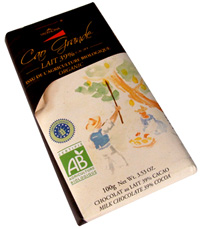 Guanaja 70%. Intense and fruity with long length and a clean finish. A remarkable chocolate from Honduras and among the highlights of Valrhona’s bars. A classic and a favorite of many connoisseurs. Guanaja 70%. Intense and fruity with long length and a clean finish. A remarkable chocolate from Honduras and among the highlights of Valrhona’s bars. A classic and a favorite of many connoisseurs. - Cao Grande Organic Bars. Introduced in 2006, a 70% bittersweet bar with Valrhona’s signature fruit flavors and a 39% caramel-and-biscuity milk bar (photo at right). They prove for once and for all that great skill in production can create great organic chocolate. As good as any Valrhona bars, they are perhaps the best organic chocolate on earth.
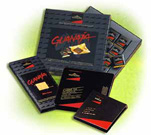
Don’t miss it: Valrhona’s Guanaja,
70% cacao, intense and fruity.
Click here to learn more about
the complex flavors and aromas
of chocolate. Learn more about Valrhona at:
Valrhona.com
Purchase Valrhona at:
Chocosphere.com
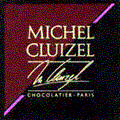 Michel Cluizel Michel Cluizel
Assertive • Flavorful • Pure
Historic Capsule
Cluizel is a family business that started in 1947 in Normandy, when pastry chefs Marc and Marcelle Cluizel decided to venture into the world of fine chocolate. Fascinated by his parents’ chocolate business, Michel became an apprentice and in 1987 opened what has come to be a renowned boutique, La Fontaine du Chocolat, on the Rue Saint Honoré in Paris. Cluizel takes immense pride in quality ingredients, using strictly cane sugar and Bourbon vanilla pods. To enable the purest chocolate flavors he avoids lecithin—an emulsifier commonly used for added smoothness and mouthfeel—so that every nuance of the cacao shines through. (To accommodate for lack of an emulsifier the conching process is longer; but no matter how long the conching, the chocolate will be thicker/pastier in the mouth than an emulsified chocolate.)
What to Know Before You Go
Without lecithin Cluizel’s texture is a tad pastier than other houses, but it has a uniquely rich smoothness. The 1er Cru de Plantation line offers an amazing array of flavor complexities, each bar having the perfect cocoa content to bring out the slightest nuance of flavor potential in the beans.
Opting for strength in his house blends, Cluizel chooses more assertive beans. The overall flavor profile is fairly noncomplex in order to deliver a solid and bolder cacao flavor. The 1er Cru de Plantation line, however, is fruitier, lighter, and more complex on the palate.
Points of Interest
- Plantation Preference. Cluizel connects the chocolate with the growers and farmers by singling out the finest plantations he can find and by working with the people directly. (Other producers, like Amedei, do this as well.) His single plantation line, aptly named 1er Cru de Plantation, produces six different chocolates from five plantations in five different parts of the world:
|
- Dominican Republic (Caribbean), Los Anconès 67%—dark
- Papua, New Guinea (South Pacific), Maralumi 64%—dark
- Madagascar (East Africa), Mangaro 65%—dark and
50%—milk
- São Tomé (West Africa), Tamarina 70%—dark
- Venezuela (South America), Hacienda Concepcion
66%—dark
|
|
- Flavors vary tremendously—from olives, berries, and apricots in Los Ancones to bananas, fresh tobacco leaves, and citrus in Maralumi. These bars spotlight the complex flavors of their regions’ fertile soils and the gentle nuances of the cacao they produce. Complex and varying, these bars challenge the palate and entice one to eat more in order to increase one's scholarship.
- The Blended Bars. House blends range in cocoa content, starting with a strong yet luscious 45% milk chocolate and ending with a powerful 99% unsweetened chocolate called Noir Infini. Cluizel aims to deliver assertiveness, and selects strong-flavored beans for the blends. But by no means is the chocolate overwhelming: It possesses a pure chocolate flavor, one that declares the very essence of cacao.
Not to be Missed
- Los Ancones 67% has an incredible complexity of unique flavors—a masterpiece that makes you wonder how flavors such as olives, berries, and apricots can exist in a piece of chocolate. The 99% cacao Noir Infini provides an awesome chocolate punch that simply must be experienced.
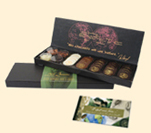
A kit, a booklet, and an evening of serious study. It really does require concentration and no
one will tell you it isn't hard work.
|
- Special Tasting Kit. Michel Cluizel explains it all for you with a convenient chocolate tasting kit, poetically called Il était une Fève... (“There was a bean...”), shown at the left.
- With tasting discs of each of gradation of chocolate, you can taste the nuances of increased percentages of cacao (cocoa), from white (which actually has cocoa butter but no cocoa powder or chocolate liquor) to 33% milk chocolate to the bittersweet 99% Noir Infini (disc shown below), which has virtually no sugar but is so rich and flavorful you'll see why none is needed.
- There are also samples of cocoa nibs, which are edible; and the cocoa butter and cocoa mass which are separated from the nibs and then processed into the discs (and bars, and bonbons, and truffles) we eat.
|
Continue to Page 2: France (cont’d) and Italy.

|















 When buying their couverture, chocolatiers and patissiers generally choose one house over another because of how the house style of the chocolate matches the palate of the chocolatier/patissier and what he or she is trying to achieve with a particular recipe. Each chocolate house has its own “recipe” for making couverture and bar chocolate—how long they roast the beans for light and fruity versus dark tones; how long they conch the chocolate for texture; whether they emulsify for smoothness; whether they add extra cocoa butter for creaminess; et al. How they treat the beans at each step in the process results in an identifiable “house style,” whether the cacao beans come from Venezuela or from Madagascar.
When buying their couverture, chocolatiers and patissiers generally choose one house over another because of how the house style of the chocolate matches the palate of the chocolatier/patissier and what he or she is trying to achieve with a particular recipe. Each chocolate house has its own “recipe” for making couverture and bar chocolate—how long they roast the beans for light and fruity versus dark tones; how long they conch the chocolate for texture; whether they emulsify for smoothness; whether they add extra cocoa butter for creaminess; et al. How they treat the beans at each step in the process results in an identifiable “house style,” whether the cacao beans come from Venezuela or from Madagascar. France
France

 The first vintage chocolate to debut, Gran Couva from Trinidad, has notes of butter, pine, and soft spice.
The first vintage chocolate to debut, Gran Couva from Trinidad, has notes of butter, pine, and soft spice. Guanaja 70%. Intense and fruity with long length and a clean finish. A remarkable chocolate from Honduras and among the highlights of Valrhona’s bars. A classic and a favorite of many connoisseurs.
Guanaja 70%. Intense and fruity with long length and a clean finish. A remarkable chocolate from Honduras and among the highlights of Valrhona’s bars. A classic and a favorite of many connoisseurs. 

